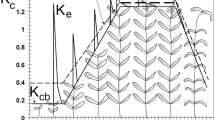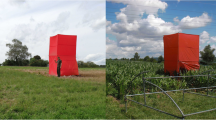Abstract
The Richmond Hill Mine heap leach pads (HLP 1&2, and HLP 3) were reclaimed in 1996 using a three-layer evapotranspiration (ET) cover designed to limit percolation of precipitation through the facilities. HLP seepage outflow rates have been measured on an approximately weekly basis. Large seasonal and wet/dry outflow cycles have been observed. Several years after the cover system installation, increased HLP drainage rates were observed, which could be due to increased permeability of the compacted layer in response to pedogenic processes such as wetting/drying, freeze/thaw, and root development. The estimated net infiltration rate during the monitoring period is about 34% of precipitation. To evaluate the cover system efficiency, a monthly time-step, spreadsheet based water balance model was created. The model considers close inter-relation between precipitation, ET, and cover net infiltration on a monthly scale and continuous feedback of water movement in the soil-plant-atmosphere continuum. The model accurately reproduced the recorded seepage rates for the monitoring period after pedogenic processes reach a stable condition.
抽象
为限制浸堆降水渗透,1996年对里士满山矿(Richmond Hill)堆浸垫(HLP 1&2和HLP 3)进行了三层蒸散发(ET)覆盖层改造。每周测量一次堆浸垫(HLP)的渗出液流量,也监测了渗出液随季节和雨季/旱季的明显周期性变化。在安装盖层系统几年之后,观察到HLP渗出液漏量增加,可能是由于压实层在经历湿润/干燥、冻融和根系发育等成壤过程中渗透性增加引起。估算监测期间的净入渗率约为降水量的34%。为评价覆盖效率,建立了每月水量均衡模型。该模型考虑了降水、蒸散发(ET)、覆盖层月净入渗量、水在土壤-植物-大气连续介质中响动运动等密切关系。该模型精确地再现了成壤过程达到稳定后监测阶段的渗流速率变化过程。
Zusammenfassung
Die Haldenlaugungspolster der Richmond-Hill-Mine (HLP 1 & 2 und HLP 3) wurden 1996 unter Verwendung einer dreischichtigen Evapotranspirations-Abdeckung regeneriert, um die Perkolation von Niederschlag durch die Anlagen zu begrenzen. Die Abflussraten der HLP-Versickerung wurden ungefähr wöchentlich gemessen. Große saisonale und nasse / trockene Abflusszyklen wurden beobachtet. Einige Jahre nach der Installation des Abdecksystems wurden erhöhte HLP-Entwässerungsraten beobachtet, was auf eine erhöhte Durchlässigkeit der verdichteten Schicht als Reaktion auf pedogene Prozesse wie Benetzen / Trocknen, Gefrieren / Auftauen und Wurzelentwicklung zurückzuführen sein könnte. Während des Beobachtungszeitraums betrug die geschätzte Nettoinfiltrationsrate etwa 34 % des Niederschlags. Um die Effizienz des Abdeckungssystems zu bewerten, wurde ein monatliches tabellenbasiertes Wasserbilanzmodell erstellt. Das Modell berücksichtigt eine enge Wechselbeziehung zwischen Niederschlag, Evapotranspiration und Netto-Infiltration durch das Abdecksystem hindurch auf monatlicher Basis sowie eine kontinuierliche Rückkopplung der Wasserbewegung im Kontinuum von Boden, Pflanze und Atmosphäre. Nachdem die pedogenen Prozesse einen stabilen Zustand erreicht hatten, reproduzierte das Modell die im Überwachungszeitraum gemessenen Versickerungsraten mit hoher Genauigkeit.
Resumen
Las pilas de lixiviación de la mina Richmond Hill (HLP 1 y 2 y HLP 3) se recuperaron en 1996 utilizando una cubierta de evapotranspiración (ET) de tres capas diseñada para limitar la filtración de precipitación a través de las instalaciones. Las tasas de flujo de infiltración de HLP se han medido aproximadamente semanalmente. Se han observado grandes ciclos estacionales y de flujo de salida húmedo/seco. Varios años después de la instalación del sistema de cobertura, se observaron mayores tasas de drenaje de HLP, lo que podría deberse a una mayor permeabilidad de la capa compactada en respuesta a procesos pedogénicos como la humectación/secado, congelación/descongelación y el desarrollo de la raíz. La tasa de infiltración neta estimada durante el período de monitoreo es aproximadamente el 34% de la precipitación. Para evaluar la eficiencia del sistema de cobertura, se creó un modelo mensual de balance de agua basado en hojas de cálculo. El modelo considera una estrecha interrelación entre la precipitación, la ET y la infiltración neta de la cobertura en una escala mensual y la retroalimentación continua del movimiento del agua en el continuo suelo-planta-atmósfera. El modelo reprodujo con precisión las tasas de infiltración registradas para el período de monitoreo después de que los procesos pedogénicos alcanzaran una condición estable.
Similar content being viewed by others
References
Albright WH, Benson CH, Waugh WJ (2010) Water balance covers for waste containment: principles and practice. ASCE Press, Reston
Apiwantragoon P, Benson CH, Albright WH (2015) Field hydrology of water balance covers for waste containment. J Geotech Geoenviron 141(2):1–19
Benson CH, Daniel DE, Boutwell GP (1999) Field Performance of compacted clay liners. J Geotech Geoenviron 125(5):390–403
Benson CH, Albright WH, Fratta DO, Tinjum JM, Kucukkira E, Lee SH, Scalia J, Schilicht PD, Wang X (2011) Engineered cover for waste containment: changes in engineering properties and implications for long-term performance assessment. Nuclear Regulatory Commission Report NUREG/CR-7028
Hargreaves GH, Samani ZA (1985) Reference crop evapotranspiration from temperature. Appl Eng Agric 1(2):96–99
Orellana R, Ludwick W, Zhan G, Baumann W, Milczarek M, Rice RC, Yao TM, Keller J (2010) Final results of the cover system test panel trials at the Pierina Mine. In: 5th International Conf on Mine Closure, Viña del Mar. Proceedings, Chile
UNESCO (1979) Map of the world distribution of arid regions. MAB Technical Note No. 7, Paris, France
Vandewiele GL, Xu CY, Win NJ (1992) Methodology of comparative study of monthly water balance models in Belgium, China and Burma. J Hydrol 134:315–347
Waugh WJ (2004) Design, performance, and sustainability of engineered covers for uranium mill tailings. In: Proc, long-term performance monitoring of metals and radionuclides in the subsurface: strategies, tools, and case studies. US Environmental Protection Agency, US Dept of Energy, USGS, Nuclear Regulatory Commission, Reston
Acknowledgements
This paper was generated from the Richmond Hill mine reclamation program. Thanks to the Richmond Hill staff for long-term data collection. Special thanks to Barrick Gold Corporation for granting permission to publish this technical summary.
Author information
Authors and Affiliations
Corresponding author
Rights and permissions
About this article
Cite this article
Zhan, G., Lattin, D., Keller, J. et al. 20 Years of Evapotranspiration Cover Performance of the Leach Pads at Richmond Hill Mine. Mine Water Environ 38, 402–409 (2019). https://doi.org/10.1007/s10230-019-00592-7
Received:
Accepted:
Published:
Issue Date:
DOI: https://doi.org/10.1007/s10230-019-00592-7











